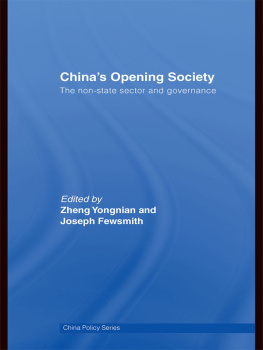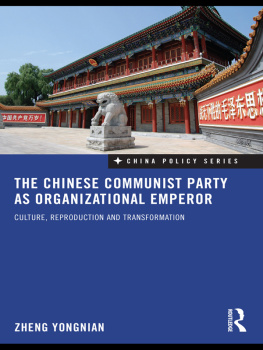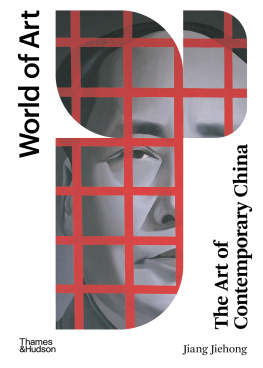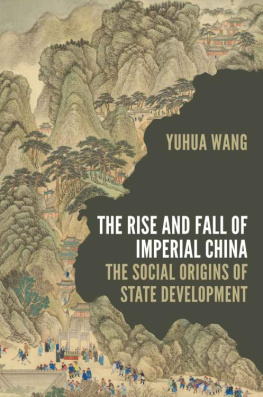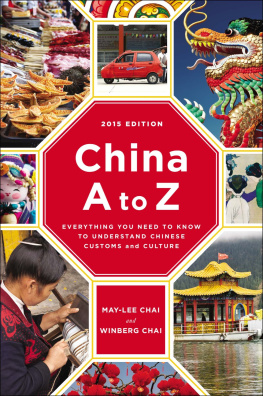
Table of Contents
A HISTORY OF THE CONTEMPORARY WORLD
General Editor: Keith Robbins
This series offers an historical perspective on the development of the contemporary world. Each of the books examines a particular region or a global theme as it has evolved in the recent past. The focus is primarily on the period since the 1980s but authors provide deeper context wherever necessary. While all the volumes offer an historical framework for analysis, the books are written for an interdisciplinary audience and assume no prior knowledge on the part of readers.
Published
Contemporary America
M. J. Heale
Contemporary Global Economy
Alfred E. Eckes, Jr.
Contemporary Japan, Second Edition
Jeff Kingston
Contemporary Latin America
Robert H. Holden & Rina Villars
Contemporary China
Yongnian Zheng
This edition first published 2014
2014 John Wiley & Sons Ltd
Wiley-Blackwell is an imprint of John Wiley & Sons, formed by the merger of Wileys global Scientific, Technical and Medical business with Blackwell Publishing.
Registered Office
John Wiley & Sons Ltd, The Atrium, Southern Gate, Chichester, West Sussex, PO19 8SQ, UK
Editorial Offices
350 Main Street, Malden, MA 02148-5020, USA
9600 Garsington Road, Oxford, OX4 2DQ, UK
The Atrium, Southern Gate, Chichester, West Sussex, PO19 8SQ, UK
For details of our global editorial offices, for customer services, and for information about how to apply for permission to reuse the copyright material in this book please see our website at www.wiley.com/wiley-blackwell.
The right of Yongnian Zheng to be identified as the author of this work has been asserted in accordance with the UK Copyright, Designs and Patents Act 1988.
All rights reserved. No part of this publication may be reproduced, stored in a retrieval system, or transmitted, in any form or by any means, electronic, mechanical, photocopying, recording or otherwise, except as permitted by the UK Copyright, Designs and Patents Act 1988, without the prior permission of the publisher.
Wiley also publishes its books in a variety of electronic formats. Some content that appears in print may not be available in electronic books.
Designations used by companies to distinguish their products are often claimed as trademarks. All brand names and product names used in this book are trade names, service marks, trademarks or registered trademarks of their respective owners. The publisher is not associated with any product or vendor mentioned in this book. This publication is designed to provide accurate and authoritative information in regard to the subject matter covered. It is sold on the understanding that the publisher is not engaged in rendering professional services. If professional advice or other expert assistance is required, the services of a competent professional should be sought.
Library of Congress Cataloging-in-Publication Data
Zheng, Yongnian.
Contemporary China : a history since 1978 / Yongnian Zheng.
pages cm
Includes bibliographical references and index.
ISBN 978-0-470-65579-5 (cloth) ISBN 978-0-470-65580-1 (pbk.)
1. ChinaHistory19762002. 2. ChinaHistory2002 I. Title.
DS779.2.Z4364 2012
951.05dc23
2012043027
A catalogue record for this book is available from the British Library.
Cover image: A man rides an electric tricycle past a truck loaded with new Volkswagen cars on a street in Nanjing. Sean Yong / Reuters.
Cover design by www.simonlevyassociates.co.uk
Figures and Tables
Chinas GDP growth, 19782009.
Industrial structure by shares in GDP.
The changing dynamics of GDP growth.
Structural distribution of national income.
Chinas share in world merchandise exports and imports, 19782008.
Coverage rates of the five social insurance schemes.
Urban and rural residents under the Minimum Standard of Living Scheme.
Share of welfare items in household consumption.
Ministries since 1949.
Hegemonization: domination and legitimation.
Cumulative FDI in China by source, 19792008.
Components of Chinas middle class by occupation.
Registered civil organizations in China, 19882009.
Two stages of decentralization.
Revenues of central and local governments.
Expenditure of central and local governments.
Series Editors Preface
The contemporary world frequently presents a baffling spectacle: New world orders come and go; Clashes of civilizations seem imminent if not actual; Peace dividends appear easily lost in the post; terrorism and wars on terror occupy the headlines. Mature states live alongside failed states in mutual apprehension. The rules of the international game, in these circumstances, are difficult to discern. What international law is, or is not, remains enduringly problematic. Certainly it is a world in which there are still frontiers, borders, and boundaries but both metaphorically and in reality they are difficult to patrol and maintain. Asylum occupies the headlines as populations shift across continents, driven by fear. Other migrants simply seek a better standard of living. The organs of the international community, though frequently invoked, look inadequate to deal with the myriad problems confronting the world. Climate change, however induced, is not susceptible to national control. Famine seems endemic in certain countries. Population pressures threaten finite resources. It is in this context that globalization, however understood, is both demonized and lauded.
Such a list of contemporary problems could be amplified in detail and almost indefinitely extended. It is a complex world, ripe for investigation in this ambitious new series of books. Contemporary, of course, is always difficult to define. The focus in this series is on the evolution of the world since the 1980s. As time passes, and as the volumes appear, it no longer seems sensible to equate the world since 1945 with contemporary history. The legacy of the Cold War lingers on but it is emphatically in the background. The fuzziness about the 1980s is deliberate. No single year ever carries the same significance across the globe. Authors are therefore establishing their own precise starting points, within the overall contemporary framework.
The series treats the history of particular regions, countries or continents but does so in full awareness that such histories, for all their continuing distinctiveness, can only rarely be considered apart from the history of the world as a whole. Economic, demographic, environmental and religious issues transcend state, regional or continental boundaries. Just as the world itself struggles to reconcile diversity and individuality with unity and common purpose, so do the authors of these volumes. The concept is challenging. Authors have been selected who sit loosely on their disciplinary identity whether that be as historians, political scientists or students of international relations. The task is to integrate as many aspects of contemporary life as possible in an accessible manner.
The analysis of Contemporary China in this volume reflects these ambitions. It combines its account of extraordinary economic development with an acute awareness of shifting political alignments and ideological formulations. It does not ignore social tensions. It knows that China is not uniform and the balance between city and country, littoral and hinterland, province and Beijing is unstable and needs to be understood. Even so, it is one China that makes its mark on the world. The strength of this account, too, is that contemporary China is situated firmly in pasts, long pasts, which overhang into the present. Here is no simple presentation of a country traveling a predictable path to modernization and democracy but rather one whose transition has its internal constraints and imperatives. An author based in Singapore and with first-hand experience of China today understands both present Western questions and Chinese answers. The outcome is a distinctive and distinguished assessment.
Next page

